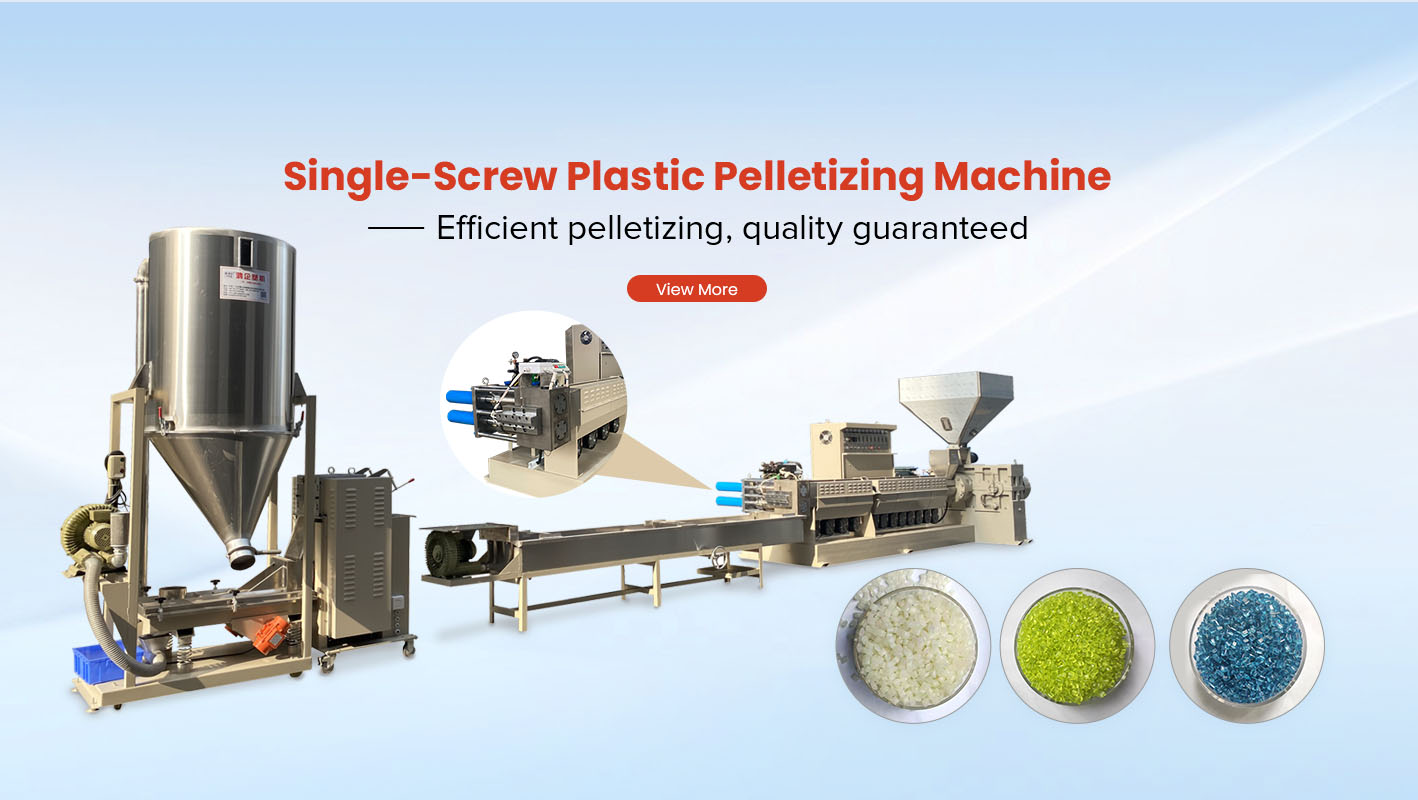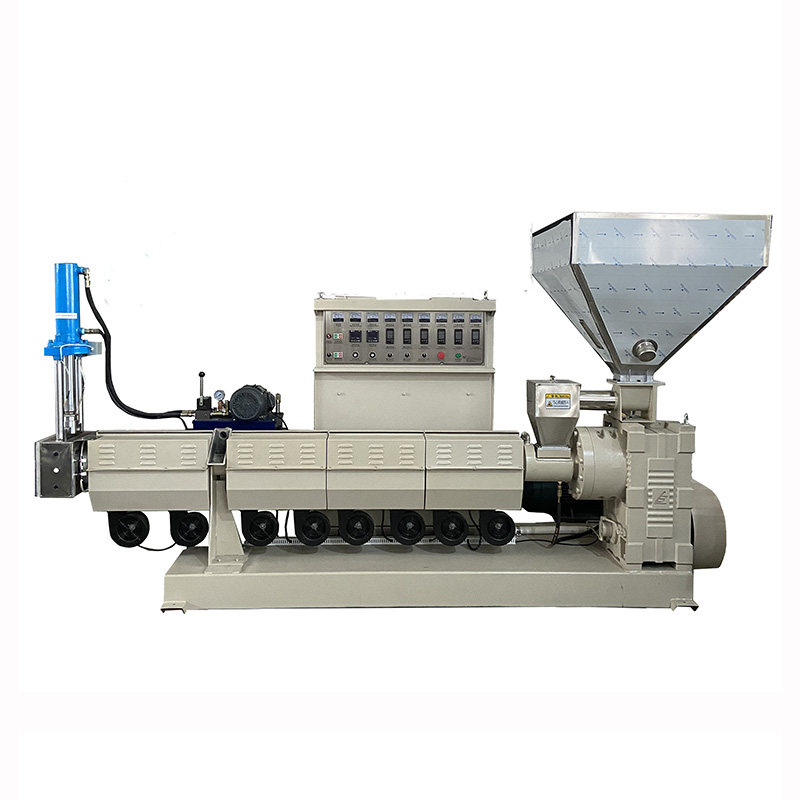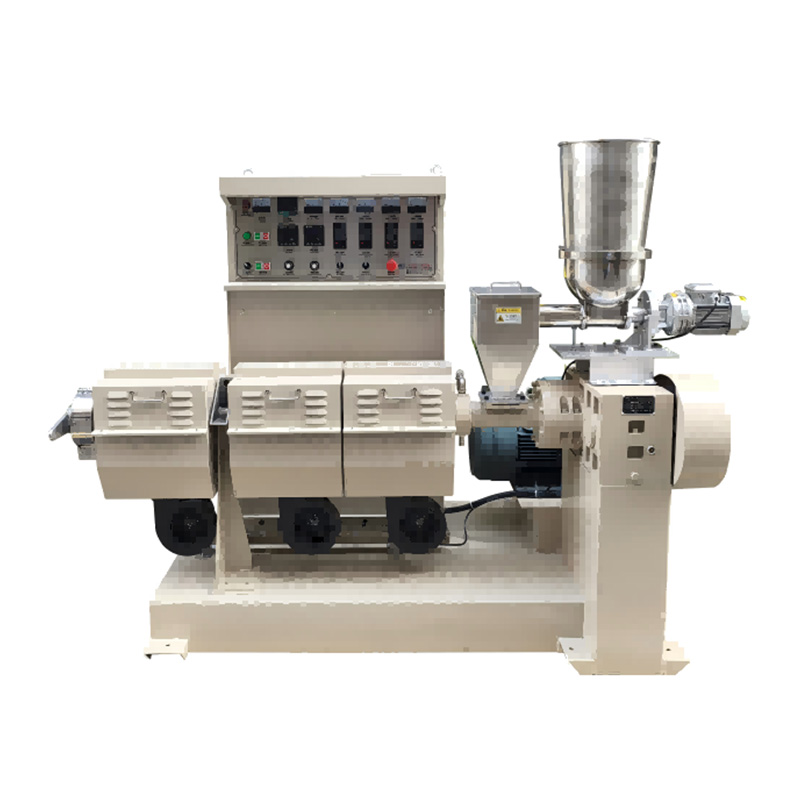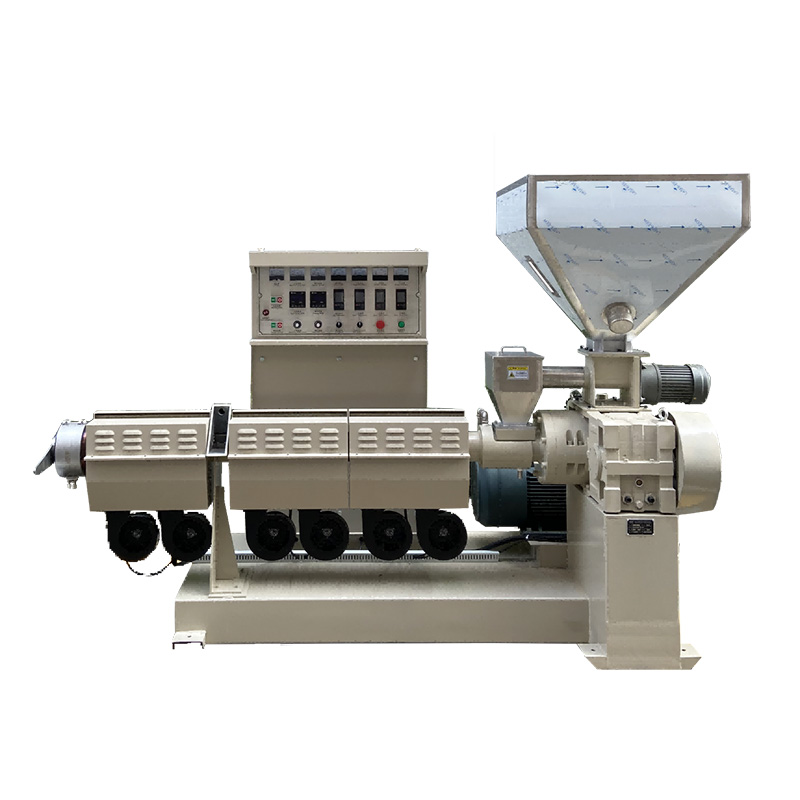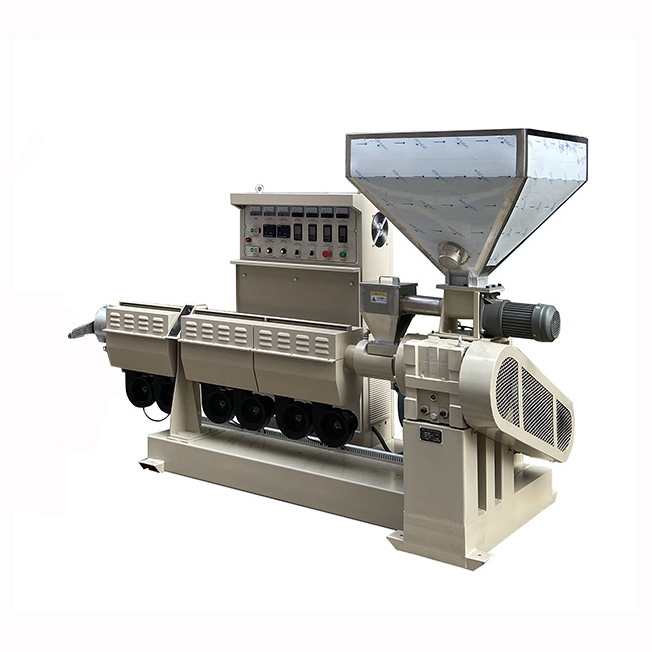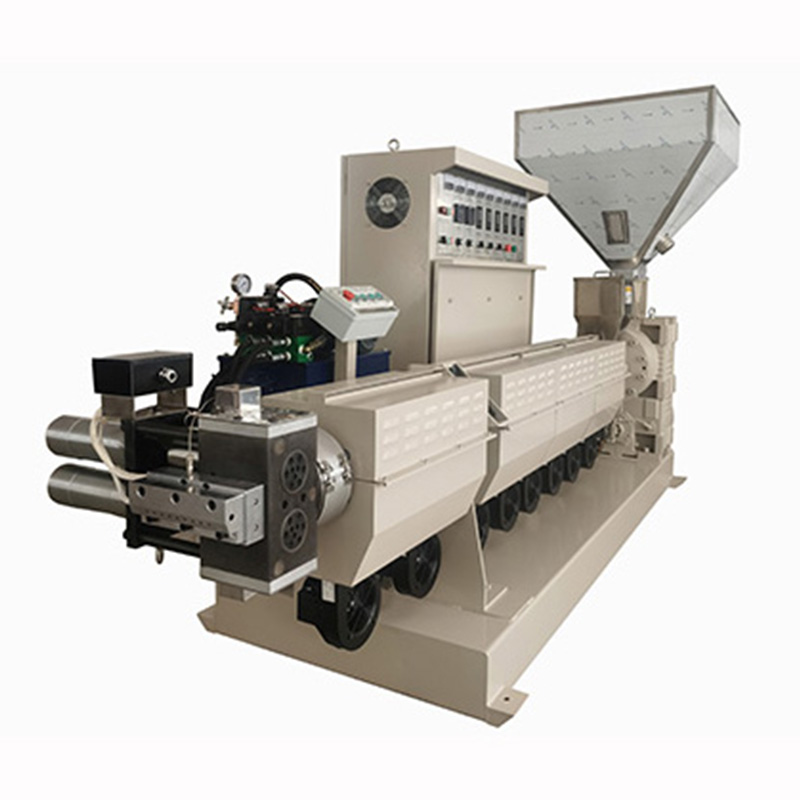Single Screw Plastic Pellet Extruder
- Product Information
plastic Pellet Extruder is a vital mechanical equipment in the plastic processing industry. It can convert various plastic raw materials, such as plastic granules, powders or recycled plastics, into plastic granules with certain shapes and sizes through processes such as heating, melting, extrusion and cooling. These granules can be further used in the production of plastic products, such as injection molding, blow molding, extrusion molding, etc.

Plastic Pellet Extruder Infomation:
| Model: | HQ-90 |
| Length-To-Diameter Ratio: | 33 |
| Applications: | The HQ-90 Single Screw Extruder Is Suitable For recycling, Pelletizing, Or Direct Product Extrusion Of Various Materials: |
| High-Performance Plastics: | PPA, HTN, PPS, PVDF, SAP, LCP, PEI, PES, PEEK, PTFE, PLA, HCR, CA |
| Commodity Plastics: | ABS, PS, HIPS, GPPS, SAN, PP, HDPE, EVA, LDPE, LLDPE, PET, PETG |
| Elastomers: | TPU, TPEE, SBS, SEBS, SIS, EPDM, SBC, POE, PVB |
| Specialty Polymers: | PE WAX, PP WAX, PVA, EAA, EMA |
| Engineering Plastics: | PA, PC, PMMA, PBT, Tritan, PC-ABS, SMMA, POM, PPO, COC, PCT |
| Additional Capabilities: | In Addition To Pelletizing, The HQ-90 Extruder Can Perform Direct Extrusion Of Films, Sheets, Plates, Tubes, And Profiles With The Appropriate Die. |
| Factory Nature: | China Manufacturers Suppliers Factory Exporter |
Plastic Pellet Extruder Parameters:
| Model | HQ-45 | HQ-65 | HQ-90 |
| Capacity | 25-50KG/HR | 80-130KG/HR | 200-300KG/HR |
| Motor (Inverter Control) | 11KW | 22KW | 55KW |
| Dimension | 2600*1000*1800mm | 2600*1000*1800mm | 3850*1800*2100mm |
| Weight | 1400KG | 1800KG | 2800KG |
| Screw | Material: SACM-1 Φ45*P45/40;L/D:33 | Material: SACM-1 Φ65*P65/60;L/D:35 | Material: SACM-1 Φ90*P90/85;L/D:33 |
| Temp. | 4 Section Control | 4 Section Control | 5 Section Control |
| Gear Oil Cooling Filter System | 1 Group | 1 Group | 1 Group |
| Barrel Cooling Fan | 180W*3PCS | 180W*6PCS | 180W*8PCS |
| Screen Changer (Die Head) | Manual Rotary | Manual Rotary Motor: 2.8KW Screen: Φ200mm | Manual Rotary Motor: 4.3KW Screen: Φ200mm |
| Auto Feeder ( Inverter Control ) | Materials: Stainless Steel, Screw L/D: 60 Motor:200W | Materials: Stainless Steel, Screw L/D: 60 Motor:400W | Materials: Stainless Steel, Screw L/D: 60 Motor:750W |
Plastic Pellet Extruder Features:
Simple structure and convenient operation: The structure of the single-screw Plastic Pellet Extruder is relatively simple, mainly composed of a screw, a barrel, a heating and cooling system, a transmission system, and a control system. This simple structure makes the operation and maintenance of the equipment relatively easy, reducing the user's use cost.
High extrusion efficiency: The Plastic Pellet Extruder pushes the plastic raw material forward through the rotation of the screw, and is heated and melted in the barrel. Due to the reasonable design of the screw, it can ensure that the raw material is fully melted in the barrel and extruded evenly, thereby improving the extrusion efficiency.
Strong adaptability: The Plastic Pellet Extruder can adapt to the processing of a variety of plastic raw materials, including polyethylene, polypropylene, polyvinyl chloride, etc. By adjusting parameters such as the screw speed, heating temperature, and cooling speed, the processing requirements of different raw materials can be achieved.
Low energy consumption: The Plastic Pellet Extruder focuses on energy saving in design, and reduces the energy consumption of the equipment by optimizing the screw structure and heating and cooling system. This not only helps to reduce production costs, but also conforms to modern environmental protection concepts.
Good stability: Plastic Pellet Extruder shows good stability during operation and can work continuously for a long time without failure. This is due to the high-quality materials and precise manufacturing process of the equipment, which ensures the reliability and durability of the equipment.
Plastic Pellet Extruder Application:
Recycling of waste plastics: Waste plastics such as plastic bottles, plastic bags, plastic films, etc. can be recycled through Plastic Pellet Extruder after pre-treatment such as collection, cleaning, and crushing. These waste plastics are processed into plastic particles and then used to produce new plastic products, realizing the recycling of resources.
Recycling of plastic scraps: In the production process of plastic products, a large amount of scraps and waste will be generated. These scraps can be recycled and reused through Plastic Pellet Extruder, reducing the waste of raw materials and reducing production costs.
Separation and recycling of mixed plastics: Plastic Pellet Extruder also has certain application potential for the recycling of mixed plastics. Through specific screw design and process parameter adjustment, different types of plastics can be separated and recycled, improving the efficiency and purity of plastic recycling.
Recycling of plastic composite materials: With the increasing application of plastic composite materials in various fields, their recycling issues are also receiving increasing attention. Plastic Pellet Extruder can achieve the recycling and reuse of plastic composite materials through specific processes and technologies, providing the possibility for the recycling of plastic composite materials.
Upgrading and development of the plastic recycling industry: The application of Plastic Pellet Extruder not only promotes the development of the plastic recycling industry, but also promotes the upgrading and transformation of the industry. By introducing advanced extrusion technology and equipment, the efficiency and quality of plastic recycling are improved, laying a solid foundation for the sustainable development of the plastic recycling industry.
Plastic Pellet Extruder Detailed Specifications:
Screw Material:
Made of 38CrMoAlA, with quenching nitride treatment, hardness more than HV900.Integral barrel design with a vacuum venting system. L/D ratio is 33:1.
Heating and Cooling:
Ceramic heating rings with cover for all 5 zones, total heating power of 50 kW.
Air cooling on the barrel, with cooling power of 180W*8=1.44 kW.
Gearbox:
High-quality domestic gearbox, featuring super torque, low noise, and stable processing.
Equipped with an oil outer recycling cooling system for the gearbox.
Motor:
AC motor with a power of 55 kW, connected with a belt, featuring a VT inverter.
Output Capacity:
Output capacity ranges from 200 to 300 kg/h.
Ensures good plasticizing and stable processing, guaranteeing uniform material distribution into the mold.
Temperature Control:
Utilizes popular parameters, mainly adopting DELIXI components.
Current, voltage, and pressure are easily displayed and controlled.
Plastic Pellet Extruder Maintainance:
Regular cleaning:
Screw and barrel: Regularly clean the residual plastic in the screw and barrel to prevent the plastic from carbonizing or degrading and adhering to the inner wall of the screw and barrel, affecting the extrusion quality and equipment performance.
Mold and pelletizing device: Regularly clean the mold and pelletizing device to ensure that the shape and size of the plastic particles meet the requirements, while preventing blockage and wear.
External surface: Keep the external surface of the equipment clean to prevent dust and debris from entering the interior of the equipment and affecting the normal operation of the equipment.
Lubrication and maintenance:
Transmission parts: Regularly check and lubricate transmission parts such as gear boxes and bearings to ensure smooth transmission and reduce wear.
Screw and barrel: According to the requirements of the equipment, regularly add an appropriate amount of lubricant to the screw and barrel to reduce the friction between plastic and metal and improve extrusion efficiency.
Check and tighten:
Bolts and nuts: Regularly check whether the bolts and nuts of various parts of the equipment are loose. If they are loose, they should be tightened in time to prevent the equipment from vibrating or shifting during operation.
Connecting parts: Check whether each connecting part is firm and reliable to ensure that the equipment will not leak or fall off during operation.
Electrical system maintenance:
Wires and cables: Check the wires and cables regularly for damage or aging. If so, replace them in time to prevent electrical failures from causing safety accidents.
Control panel: Keep the control panel clean and dry to prevent dust and moisture from entering the control panel and affecting the normal operation of electrical components.
Motor: Check the operating status of the motor regularly, such as temperature, vibration, etc., to ensure the normal operation of the motor and prevent equipment shutdown due to motor failure.
Heating and cooling system maintenance:
Heater: Check the heating effect of the heater regularly to ensure that the plastic raw materials can be evenly heated and melted. At the same time, pay attention to the safe use of the heater to prevent overheating and fire.
Cooling system: Check the cooling effect of the cooling system regularly to ensure that the plastic particles can be cooled and shaped in time after extrusion. At the same time, pay attention to the cleaning and circulation of cooling water to prevent blockage and corrosion.
Regular maintenance:
Replacement of wearing parts: According to the use of the equipment and the service life of the wearing parts, regularly replace wearing parts such as screws, barrels, molds, etc. to ensure the normal operation and production efficiency of the equipment.
Comprehensive inspection: Regularly conduct comprehensive inspection and maintenance of the equipment, including various components of the equipment, electrical systems, heating and cooling systems, etc., to ensure that the equipment is in good working condition.
Operation specifications:
Train operators: Provide professional training to operators to familiarize them with the operating procedures and precautions of the equipment to ensure that the equipment operates under correct operation.
Comply with operating procedures: Formulate and comply with the operating procedures of the equipment, such as preparation before startup, monitoring during operation, cleaning after shutdown, etc., to ensure the safe operation and production efficiency of the equipment.

